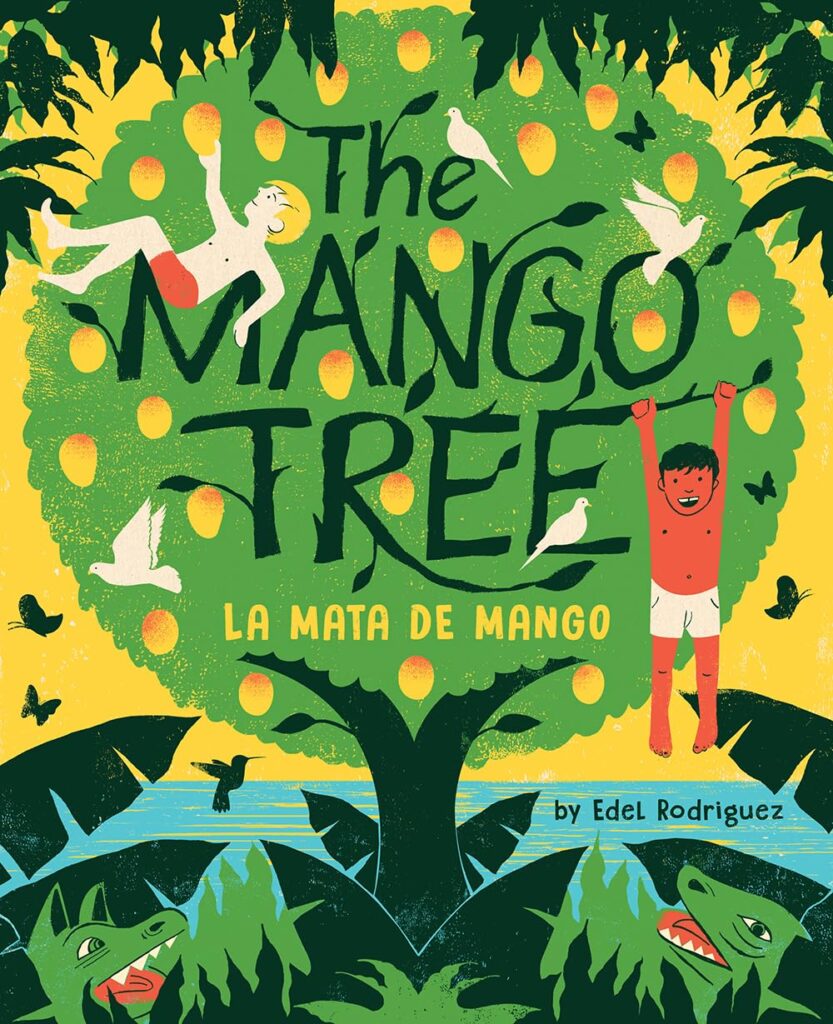How can a wordless book be bilingual? The beauty of a great wordless book is that it belongs to everyone anywhere. Sure, the story might be one that readers from another area have no chance of actively doing themselves, but it’s an entertaining one that offers something that they can take away. The Mango Tree or La Mata De Mango is a wordless book whose only language difference is evident by its two titles and the fact that the author’s note is in Spanish and English. The story in The Mango Tree is a simple one of friendship, childhood discovery, change, adventure, and adaptation.

Ok, so the story is more complex than what you might be thinking of when you hear “wordless book.” The Mango Tree is a wondrous adventure about growing up with a best friend and the way that the two of you passed the time doing that special thing. In this case, the two boys spend each waking day in the mango tree, eating its fruit, napping on the branches, flying kites from its uppermost branches and looking at the animals on the jungle floor. The odds of me ever being in a mango tree, much less relaxing in one, are near zero. I have a hard enough time trying to find that perfectly ripe mango to where I can cut it up to make salsa.
One day these two boys are up in the mango tree, as they usually are, when a massive storm comes up on the island. Its winds blow all the fruit, except for one lonely mango, off of the tree, and pushes the tree into the ocean where it becomes its own boat. The tree floats along seeing all sorts of scary fish at night until it lands on another island that’s seemingly more desert-like. The people on this island are welcoming, but they don’t have any mango trees. Thankfully, he still has one mango that successfully made it through the storm. He plants that mango in the ground and readers can see it grow to where the islanders enjoy the tree to the same degree that he did prior to this.
The Mango Tree screams at young audiences with bright, vibrant colors that are at home in a tropical environment. The island location makes the orange yellow of the mangos pop while the blackness of the storm contrasts the aqua tones of the night ocean. Once the tree lands at its new destination the island is different and the new plants all but poke you with their glochids.
The great thing about wordless books is that when they connect, they really hit home. The Mango Tree is a wordless book that runs with energy. Young kids don’t need to know anything about a mango, but their imagination will fill in the blanks as to what the boys are thinking, the specifics of where they are, the adventure of the boy who crossed the ocean, and the unknown factors of when he landed on the new beach. The colors in the book are great also because had they been on the neon side of bright colors it probably would’ve been annoying. As they are in The Mango Tree, they’re slightly muted and the paper that they’re printed on has a natural, slightly rough feel to it.
Much like the colors and their balance, had the paper been glossy, the book wouldn’t have had the name atmosphere. This is a book about a childhood ritual, their friendship, and the adventure that one of them takes. Glossy pages would’ve given the book a more polished appearance, and this is a book about adventure. The slightly rough texture of the paper gives readers the impression that this book’s pages were pounded from the pulp of a coconut or mango skin. Obviously, that’s not the case, but young readers might subconsciously appreciate the more natural feel of the pages as they lose themselves in the tale of a kid and their adventures.
The Mango Tree (La Mata De Mango) is by Edel Rodriguez and is available on Abrams Books for Young Readers, an imprint of Abrams Books.
There are affiliate links in this post.





 Facebook
Facebook Twitter
Twitter Flickr
Flickr GooglePlus
GooglePlus Youtube
Youtube